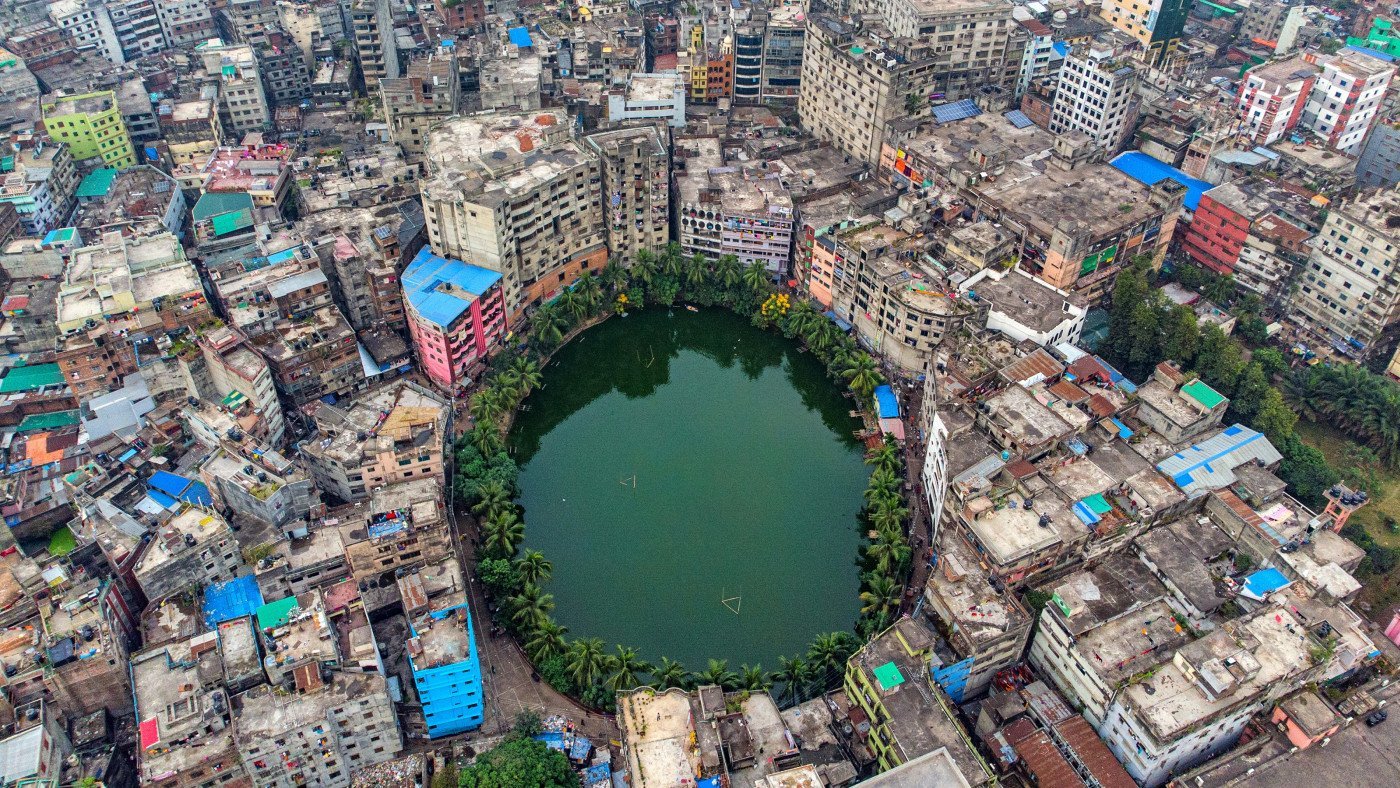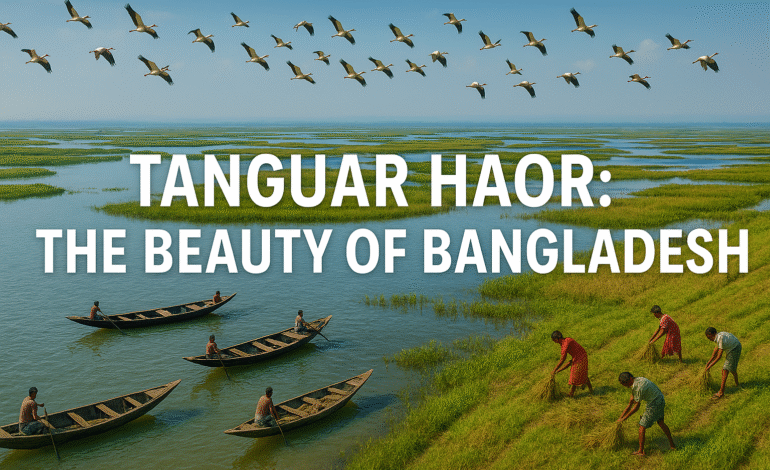More Than a Wetland
Tanguar Haor in Bangladesh is more than a wetland. It is a living treasure that supports people, wildlife and the environment. Located in the Sunamganj district of Sylhet division, this unique ecosystem covers around 9,727 hectares of floodplain. Recognized internationally, it was declared an Ecologically Critical Area (ECA) in 1999 and designated as a Ramsar Site in 2000, making it one of the most important wetlands in South Asia.
Over 40,000 people from 88 villages depend directly on this haor for fishing, farming, and daily living. The IUCN Bangladesh and other organizations have documented its immense biodiversity, highlighting more than 200 bird species and over 150 fish species that thrive in its waters. According to the Bangladesh Haor and Wetland Development Board, Tanguar Haor contributes significantly to food supply, flood control, and ecological balance.
The Geography of Tanguar Haor
Tanguar Haor lies at the base of the Meghalaya hills of India, where streams and rainfall feed its vast basin. During the monsoon, the haor floods and turns into a massive inland sea, often stretching over 20,000 hectares with its wetlands and floodplains combined. In winter, water levels recede, creating small patches of land where farmers cultivate paddy and vegetables.
The changing landscape between wet and dry seasons makes it a dynamic ecosystem. This seasonal rhythm shapes both human livelihoods and wildlife behavior.
Biodiversity of Tanguar Haor
Tanguar Haor is a paradise for biodiversity. More than 200 species of birds have been recorded here, including migratory birds that travel thousands of kilometers from Siberia, Central Asia, and Europe. In winter, the haor becomes a sanctuary for ducks, geese, and rare species like the Pallas’s Fish Eagle.
The wetland also hosts 150 species of freshwater fish, including hilsa, catfish, carp, and snakehead. Many of these species breed in the haor before moving to other rivers and floodplains. Amphibians, reptiles, and aquatic plants further enrich the ecosystem.
According to Ramsar Wetlands, the site is globally significant for maintaining biodiversity and supporting migratory species across Asia.
Dependence of People on Tanguar Haor
Tanguar Haor is not just about wildlife; it is a lifeline for people. Around 40,000 residents from 88 villages rely on it for fishing, agriculture, and cattle rearing.
Fishing is the backbone of local livelihoods. The haor produces nearly 25,000 tons of fish annually, contributing heavily to Bangladesh’s inland fisheries sector. During winter, when water levels drop, farmers grow paddy, which is a staple crop for the country.
Beyond food, the haor provides water, reeds for roofing, and grazing fields for cattle. For the poor, it is their survival base.
Rivers, Floods, and the Role of the Haor
Tanguar Haor plays a vital role in flood management. During monsoon, when heavy rainfall from the Meghalaya hills pours into Bangladesh, the haor stores excess water like a natural reservoir. This storage prevents catastrophic flooding in surrounding villages and helps maintain river balance downstream.
It also recharges groundwater, supports soil fertility, and maintains ecological flow for nearby rivers like Surma and Kushiyara. In this way, the haor protects millions of people in Sylhet and beyond.
Cultural and Heritage Value
Rivers and wetlands are deeply rooted in Bengali culture, and Tanguar Haor is no exception. Folk songs, especially Baul and Bhatiali, often draw inspiration from the beauty of wetlands. Boat races are held during monsoon, attracting thousands of visitors.
Tanguar Haor is also a growing tourist destination. Every year, thousands of local and foreign travelers visit for birdwatching, photography, and boat tours. Eco-tourism has the potential to create sustainable income while raising awareness of wetland protection.
Economic Importance of Tanguar Haor
The economic role of Tanguar Haor is immense. Fishing alone sustains thousands of families and contributes significantly to the local economy. According to the Department of Fisheries, inland capture fisheries, including haors like Tanguar, provide nearly 40 percent of total fish production in Bangladesh.
Tourism is another growing sector. Boat rentals, guides, and local markets benefit from the influx of visitors. Handicrafts and local food products also see increased demand. If properly developed, eco-tourism in Tanguar Haor could generate millions in revenue annually.
Challenges Facing Tanguar Haor
Despite its value, Tanguar Haor faces several threats. Overfishing is reducing fish populations, while illegal netting practices harm breeding cycles. Pollution from nearby settlements and agriculture degrades water quality.
Deforestation in surrounding hills leads to heavy siltation, reducing water depth and threatening biodiversity. Climate change adds further risks, with irregular rainfall and higher temperatures disrupting the wetland’s seasonal cycle.
Encroachment is another major issue. Land grabs and unplanned agriculture disrupt the ecological balance, putting both wildlife and local people at risk.
Conservation Efforts and Solutions
The government, NGOs, and local communities are working together to save Tanguar Haor. In 2001, the government leased out fishing rights to local cooperatives, ensuring sustainable management. The IUCN Bangladesh has supported community-based conservation, where villagers directly manage resources.
Awareness campaigns promote responsible fishing and protect migratory birds. Eco-tourism projects are being developed with community participation, creating alternative income opportunities.
Future solutions must include stricter law enforcement, restoration of degraded areas, and expansion of research. International partnerships can also help secure funding for conservation.
The Future of Tanguar Haor
Tanguar Haor is not just a wetland. It is a mirror of Bangladesh’s survival as a delta nation. Protecting it ensures food security, cultural identity, and ecological balance.
If properly managed, Tanguar Haor can be a global model of sustainable wetland management. It can provide livelihoods, conserve biodiversity, and fight climate change at the same time. The choice lies in how Bangladesh and its people value this natural treasure.








